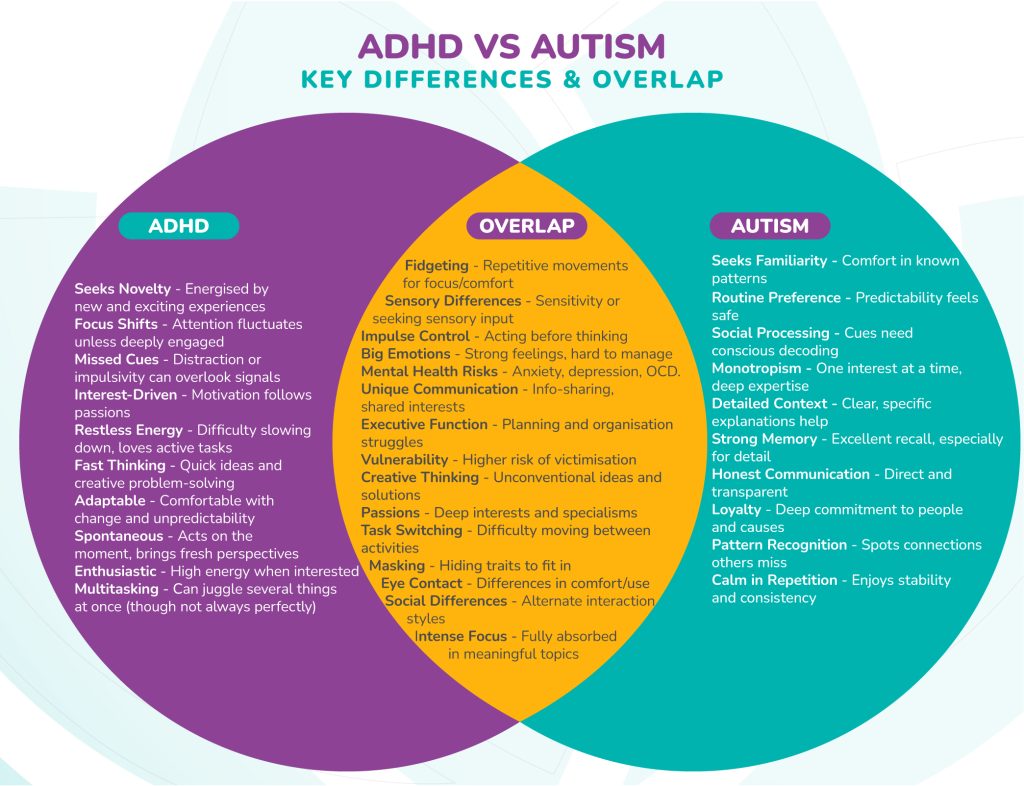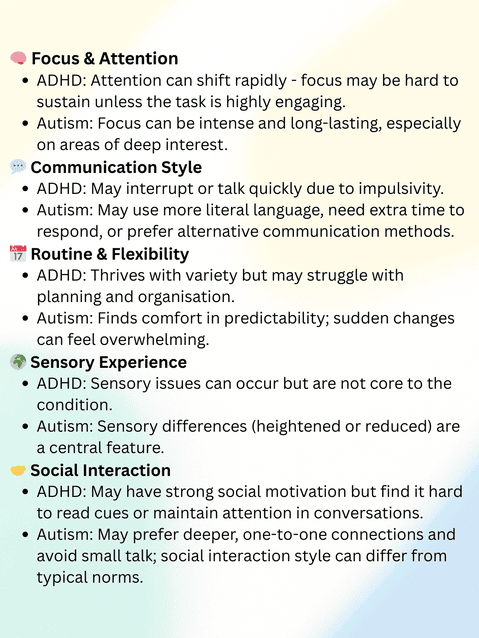Definitions and assumptions about ADHD and autism can sometimes create confusion, especially when it comes to how they relate to one another. It might surprise some to learn that these two neurodevelopmental differences can occur together, even though certain traits may seem to point in opposite directions. For example, autistic people often value routine and predictability, while those with ADHD may become restless with repetition and seek variety, spontaneity, and new experiences.
Recent research highlights how often this overlap happens: around 50–70% of autistic people also meet the criteria for ADHD, and roughly 20% of people diagnosed with ADHD are also autistic. This co-occurrence has led to the use of the term AuDHD to describe people who experience both.
Living with AuDHD can bring a distinctive mix of perspectives, abilities, and support needs. While challenges can arise – particularly around attention, organisation, sensory processing, or adapting to change – many also find that the combination shapes creative problem-solving, depth of focus, and resilience in unique ways.

ADHD – Definition and Characteristics
Attention deficit hyperactivity disorder ADHD is a neurodevelopmental difference where the brain processes information and responds to the world in unique ways. Children and young people with ADHD may experience challenges such as staying focused or sitting still, but they often show strengths like creativity, curiosity, problem-solving skills, and high energy. With the right strategies and support, these differences can be managed in ways that help each person thrive.
ADHD often becomes noticeable in childhood, usually before the age of 12. It affects how people focus, manage their energy, and regulate their reactions. Signs can be linked to attention, activity levels, or impulsive behaviour – and for many, a blend of all three.
When attention is affected, a child or young person might:
- Drift off easily or get sidetracked during tasks
- Miss parts of what’s being said or lose track of instructions
- Overlook daily routines, like personal care or getting dressed
With higher energy or impulsive tendencies, they might:
- Have a constant drive to move and explore
- Fidget, tap, or find it difficult to remain seated
- Speak out of turn or jump into conversations with enthusiasm
- Act quickly without always pausing to think
While some people show mainly one pattern, most experience a mix of attention-related and activity-related traits. ADHD is sometimes identified less frequently in females, possibly because their signs often present as quieter, less obvious attention challenges.
It’s common for young children, particularly under the age of five, to be full of energy, act on impulse, or lose focus easily. This doesn’t necessarily indicate ADHD – sometimes it’s simply a response to feeling tired, anxious, or under stress.
Autism – Definition and Characteristics
Autism spectrum disorder (ASD) is a neurodevelopmental difference that shapes how a person experiences the world. It influences communication, social interaction, thinking patterns, and sensory processing in unique ways. Autism is described as a spectrum because it includes a wide range of strengths, abilities, and support needs. Each autistic person’s experience is distinct – no two journeys are the same.
While some autistic people may find change or social situations challenging, others might excel in problem-solving, creativity, or specialist interests. Many autistic children and adults prefer routine and predictability, while others thrive in more flexible, exploratory environments. Recognising and respecting each person’s individuality is key to creating understanding and meaningful inclusion.
Autistic Person – Characteristics
An autistic person may:
- Communicate in ways that differ from what’s typical, such as using fewer words, alternative communication, or non-verbal expression.
- Enjoy deep focus on specific interests, developing remarkable knowledge or skill in these areas.
- Prefer predictable routines and find sudden changes unsettling.
- Experience the world through heightened or reduced sensitivity to sights, sounds, textures, tastes, or smells.
- Build connections in their own way – valuing authenticity over small talk.
- Approach problem-solving with unique perspectives, offering fresh insights in work, study, or daily life.
Can ADHD and Anxiety Look Like Autism?
Yes – ADHD and anxiety can sometimes present in ways that resemble autism, especially when it comes to social interaction, focus, and coping with change. For example, difficulty maintaining attention, feeling overwhelmed in busy environments, or avoiding certain situations can be seen in all three. However, the reasons behind these behaviours differ, which is why a thorough assessment by a qualified professional is important for an accurate diagnosis and the right support.
What is the link Between ADHD and Autism?
Although both ADHD and autism are neurodevelopmental conditions, ADHD was never classified as a pervasive developmental disorder (PDD). ADHD appears under its own category in diagnostic systems, separate from autism. By contrast, PDD referred exclusively to a group of conditions – such as classic autism, Asperger syndrome, childhood disintegrative disorder, and PDD‑NOS – that were grouped together and later subsumed under the umbrella of autism spectrum disorder (ASD) with the release of the DSM‑5 in 2013.
While ADHD is not a PDD, research has shown considerable co‑occurrence and symptom overlap between the two. In fact, ADHD is the most common comorbid condition in children with ASD, and up to about one quarter of children diagnosed with ADHD display some low-level autism traits. Early DSM versions (like DSM‑IV) even treated PDD as an exclusion for an ADHD diagnosis – meaning if a PDD was diagnosed, ADHD wasn’t – but this has since evolved to allow dual diagnoses where appropriate
Key Differences Between ADHD and Autism
ADHD and autism are both lifelong neurodevelopmental differences, yet the way they shape daily life is not the same. While they can overlap – making it possible for a person to have both – their core features stem from different underlying processes. ADHD diagnosis is typically linked to patterns of attention, impulse control, and activity levels that can shift quickly depending on interest or stimulation.
Autism, on the other hand, is characterised by a distinct way of perceiving and interacting with the world, often involving differences in social communication, sensory experience, and a preference for consistency. Recognising where these patterns diverge not only supports accurate diagnosis but also ensures that each person receives understanding and strategies that fit their unique needs.

Primary Signs
While ADHD traits are often associated with high energy levels, restlessness, and impulsive actions, autism is more commonly linked to repetitive movements or behaviours, such as hand-flapping or arranging objects in a specific order. These core differences can influence how each condition appears in daily life.
Social Skills and Communication
People with ADHD are often socially driven, eager to connect, and quick to join conversations – though impulsivity may lead to interrupting or shifting topics abruptly. In contrast, autistic people may find it harder to read social cues or navigate unspoken rules, which can make social interaction feel less intuitive.
Focus and Attention
ADHD can involve difficulty sustaining attention, especially during tasks that are repetitive or uninteresting, leading to frequent shifts between activities. Autism, however, is often marked by the ability to maintain deep and prolonged focus on specific subjects or interests, sometimes to the exclusion of other activities.
Developmental Pathways
Support for ADHD often centres on managing attention and impulse control, and with effective strategies, many can experience few long-term difficulties. Autism, by contrast, typically involves lifelong differences in communication, sensory processing, and social interaction, meaning that consistent understanding, adaptations, and inclusive environments remain important throughout life.
Key Similarities Between ADHD and Autism
ADHD and autism are different ways of experiencing the world, yet they can share some patterns that shape daily life. These similarities often come from how the brain organises information, responds to surroundings, and processes feelings.
Executive Function Challenges
Planning, organising, and managing time can sometimes feel more complex for people with ADHD or autism. This might mean needing extra tools or routines to keep track of tasks, remembering steps in a process, or finding the right pace for completing something. While the reasons may be different, many discover that strategies like visual planners, reminders, and supportive environments can help in both experiences.
Emotional Regulation Difficulties
Both ADHD and autism can involve feeling emotions strongly – whether that’s joy, enthusiasm, frustration, or worry. At times, these feelings may become overwhelming, making it helpful to have calming techniques, breaks, or supportive spaces. Recognising and validating these emotions is an important part of understanding both conditions.
Co-occurrence (Comorbidity)
The autism and ADHD co-occurrence can bring a distinctive mix of strengths and areas where extra support is helpful. Understanding this overlap means support can be shaped around the whole person, not just one part of their experience.
Myths and Facts about Autism and ADHD
| Myth | Fact |
|---|---|
| “If a child can sit still sometimes, they can’t have ADHD.” | Focus and activity levels can vary throughout the day. A child might sit calmly for an activity they enjoy but still experience ongoing attention or regulation differences. |
| “Autistic people avoid all eye contact.” | Some autistic people make natural eye contact, others prefer less – it’s simply one aspect of communication style, not a universal trait. |
| “Being shy is the same as being autistic.” | Shyness is a temporary social feeling, while autism shapes communication and sensory processing in consistent ways across time and situations. |
| “ADHD means not listening.” | People with ADHD can hear what’s said but may process it differently, especially if their attention is already focused elsewhere. |
| “Repetitive play or routines are bad habits.” | Repetition can be comforting, help with learning, and bring enjoyment – it’s not inherently negative. |
| “If someone is talkative, they can’t be autistic.” | Autistic people can be quiet, talkative, or anywhere in between. Communication style is individual, not a fixed rule. |
| “Fidgeting is rude.” | Movement, like tapping or doodling, can help with focus, regulation, or processing information. |
| “If a person makes friends easily, they can’t have ADHD or autism.” | Friendships are possible for everyone, though the way people connect, maintain, or seek friendships may differ. |
| “Avoiding group activities means a lack of interest in people.” | Large or noisy groups can be overwhelming; smaller or quieter settings may feel more comfortable. |
| “If someone does well at school or work, they can’t have ADHD or autism.” | Many people develop strategies to thrive in certain environments, even if they face challenges in others. |
Importance of Accurate Early Diagnosis
An accurate early diagnosis helps people and families understand what’s going on sooner, so support can be shaped around how the person thinks, learns, and communicates. It guides the right assessments (including for co-occurring differences such as ADHD and autism), reduces “diagnostic overshadowing,” and opens doors to evidence-based interventions, school adjustments, and benefits that might otherwise be missed.
Early clarity also lowers stress for carers and teachers, sets realistic expectations, and prevents trial-and-error approaches that waste time and confidence. In short, it brings the right help to the right person at the right moment.
Support Strategies
Effective support begins with a collaborative plan that includes the person, their family, and their wider team. Communication should be clear – using plain language, visuals, or alternative methods where helpful – and routines should be predictable while allowing for gentle, well-prepared changes. Reducing pressure is key: break activities into smaller steps, allow extra time, and offer meaningful choices about how to start, pause, or complete a task.
Practical strategies might include:
- Visual schedules, timers, and checklists to support planning and organisation
- Movement breaks, quiet spaces, or calming activities to maintain emotional regulation
- Using strengths and interests as a base for learning and engagement
- Regularly reviewing the plan to keep support relevant and effective
Get Autism Support with Catalyst Care Group
At Catalyst Care Group, we support people with autism, adhd and other neurodevelopmental differences. Our support is focused on understanding each person’s needs and challenges while recognising and developing people’s unique skills and strengths.
We provide person-centred care that’s combined with creative and innovative methods to make a genuine, lasting difference in people’s lives.
To support clear and accessible communication, we use multimedia tools and various techniques that adapt to how each person processes information. This includes the use of video avatars, social stories, and interactive digital resources that support communication in ways that feel right for each person.
Our teams provide a trauma-informed approach to care, recognising that past experiences can shape how a person feels, communicates, and responds to the world. Our autism support services are built around creating safety, trust, and a sense of control, always focusing on the person beyond a diagnosis.
As a certified PROACT-SCIPr-UK® training centre, we empower our teams with the skills to provide thoughtful, proactive support that respects each person’s choices, needs, and rights. Through our training and day-to-day practice, we focus on:
- Identifying and reducing triggers using emotional and sensory awareness
- Applying personalised, non-restrictive strategies tailored to the person
- Building communication skills and everyday confidence
- Strengthening emotional resilience through trauma-sensitive methods
We work closely with autistic people, their families, and other professionals to develop personalised care plans that reflect their values, aspirations, and vision for the future.
If you are looking for a reliable and consistent care provider, get in touch with us today.













